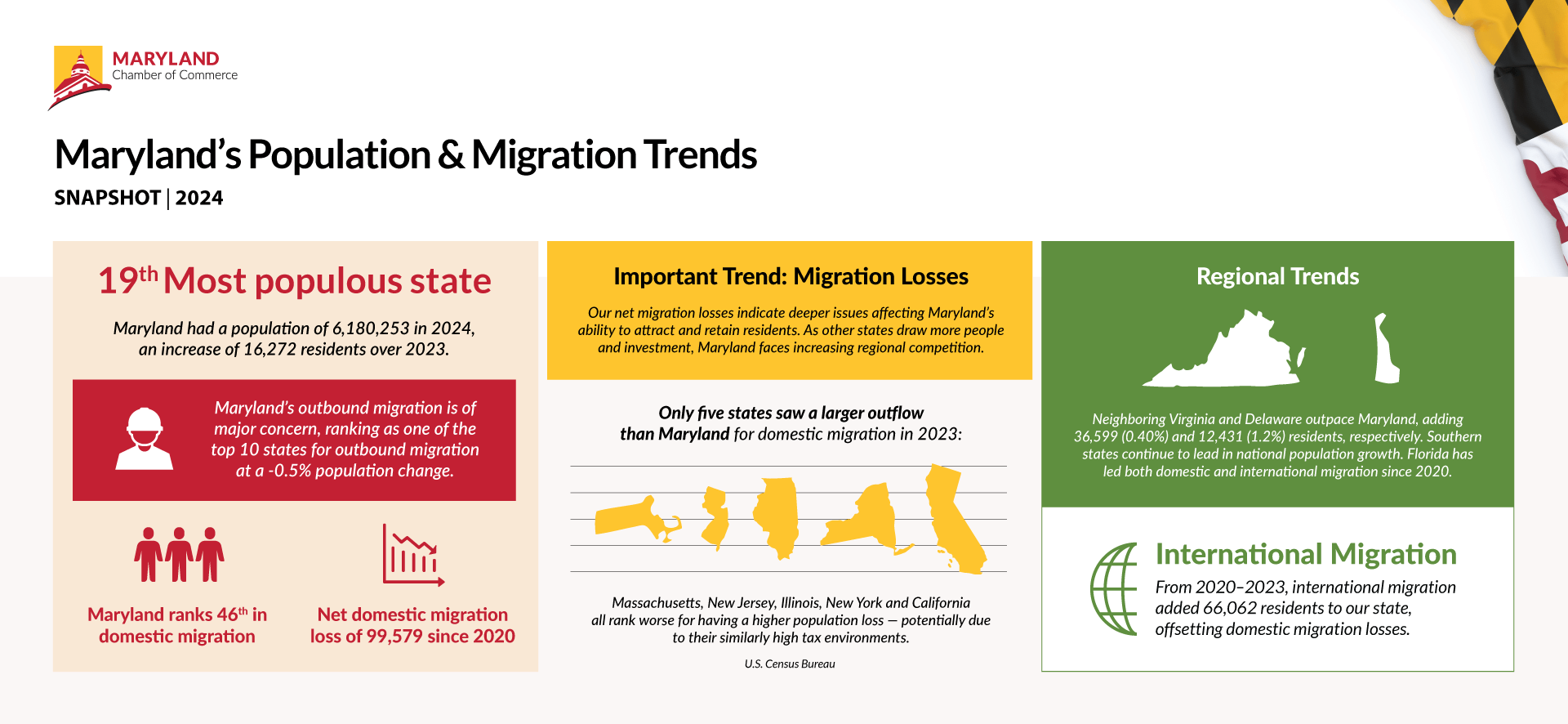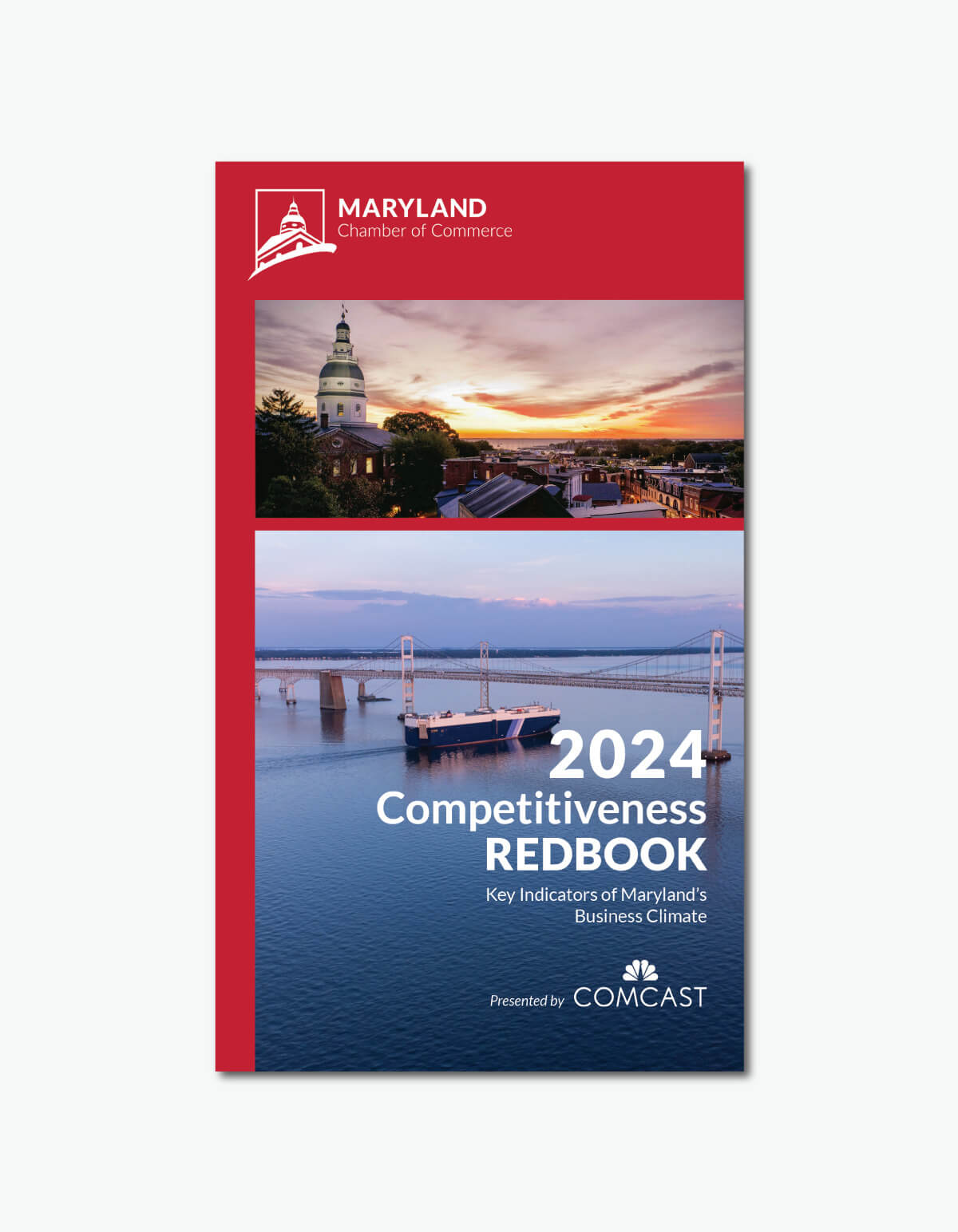Blog
Charting Maryland’s Economic Competitiveness in 2024: Population & Migration
Oct 29, 2024
Examining Population and Migration Trends in Maryland
Recent population and migration trends data show concerning trends for Maryland’s economic competitiveness.
Challenges to Competitiveness
Neighboring states, like Virginia and Delaware are seeing significant population growth while Maryland is seeing our population growth stagnate.
Only five states saw a larger outflow from domestic migration in 2023: Massachusetts, New Jersey, Illinois, New York and California all rank worse for having a higher population loss.
Southern states like Florida, Texas, North Carolina, South Carolina, Tennessee and Georgia are seeing booming population expansions.
Our net migration losses indicate deeper issues affecting Maryland’s ability to attract and retain residents. As other states draw more people and business investment, Maryland faces increasing regional competition.
U.S. Census, Pew Charitable Trust: Population & Migration
| Md '22 | Md '23 | Md '24 | Va '23 | Pa '23 | De '23 | Best | |
| State Population | 19 | 19 | ≡ 19 | 12 | 5 | 45 | Calif. |
| Population Change | 40 | 43 | ↑ 24 | 8 | 47 | 26 | Texas |
| Population Change Percent | 38 | 40 | ↑ 32 | 23 | 44 | 6 | S. Carolina |
| Total Net Migration | -- | -- | 42 | 12 | 43 | 21 | Florida |
| Net Domestic Migration | 44 | 44 | ↓ 46 | 39 | 44 | 13 | Florida |
| Net International Migration | 12 | 14 | ↑ 8 | 12 | 14 | 13 | Florida |
Population & Migration: 2020–2023
| MD | VA | PA | DE | Best | |
| Population Change | 33 | 14 | 37 | 19 | Texas |
| Population Percent Growth | 34 | 23 | 41 | 7 | Idaho |
| Net Total Migration | 45 | 21 | 26 | 20 | Florida |
| Domestic Migration | 45 | 40 | 41 | 16 | Florida |
| International Migration | 12 | 9 | 13 | 45 | Florida |
Data Trends
Population Growth:
- Maryland's population grew by 16,272 (0.30%) in 2023, ranking 24th for population change and 32nd for percentage change - an improvement from 2022.
- Virginia and Delaware outpaced Maryland, adding 36,599 (0.40%) and 12,431 (1.2%) residents respectively.
- Southern states continue to lead in population growth, while Northeastern states generally face population losses.
Migration:
- Maryland ranked 42nd for total net migration in 2023, gaining 2,072 residents.
- The state lost 30,902 residents to domestic migration (46th in the nation) but gained 32,977 through international migration (8th).
- Virginia and Delaware showed stronger migration patterns, particularly Delaware's domestic migration (13th nationally).
- Southern states, especially Florida, lead in both domestic and international migration gains.
2020–2023:
- When looking at population growth and migration for 2020 through 2023, Maryland ranks poorly. In that timespan, our state gained just 3,000 residents. Alarmingly, we lost 99,579 residents via domestic migration to other states, ranking 45th worst in the country. International migration added 66,062 residents to our state, helping to offset the domestic migration loss.
Working Towards a Solution
Population growth stagnation points to deeper challenges affecting our ability to attract and retain residents and talent. Addressing these challenges requires a multi-faceted approach focused on business growth, incentives, infrastructure, and education. By investing in the drivers that attract residents and companies — from skilled workforces to business-friendly policies — Maryland can reverse troubling trends and chart a better path forward.
Sources
- State Populations: U.S. Census Bureau (2021, 2022, 2023 data)
Key Takeaways
Maryland's stagnant population growth and migration losses reveal deeper challenges in attracting and retaining residents and talent. With the decline in the prime working-age group (ages 25-54), both consumer spending and tax revenues are taking a hit. Meanwhile, states like North Carolina and Georgia, with their booming economies, offer strong competition, having discovered successful strategies for rapid growth.
Why it Matters
Population stagnation and decline have serious implications. They reduce the tax base, create workforce shortages and shrink the consumer market — all of which weaken Maryland’s economic competitiveness. Fewer people paying taxes means less funding for schools, roads, hospitals and other vital infrastructure. As a result, residents and businesses that remain in Maryland may face higher taxes to make up for the lost revenue.
Additional Reading
Maryland’s economic woes predate pandemic, report finds (Washington Post, 2024)
Economist calls for growing state population to grow economy (Maryland Matters, 2023)
10 States People Are Fleeing And 10 States People Are Moving To (Forbes, 2023)
America’s Labor Shortage: The Most Impacted States (U.S. Chamber of Commerce, 2023)




Why Businesses Like Yours Trust Us to Deliver Results